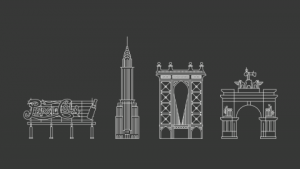From the Series
A Dutch plant laboratory is revolutionising the way we might grow food for the increasing population of Africa. Gertjan Meeuws, partner, engineer and horticulturalist at Plenty 50, is putting forward a radical new approach to growing food locally in closely monitored conditions: environments he is calling “plant paradise”. Meeuws suggests that the farms of the near future will be in skyscrapers, warehouses or underground in cities – not in fields.
“How would plant paradise look if plants could make a choice?” says Meeuws. “So we’ve been doing a Q&A with them [the plants], and they give some very decisive answers if you ask the right way.”
Plenty 50 has measured the optimum conditions for plants to yield high quantities of food. For example, plants can only absorb 9% of sunlight, using only the red and blue light in photosynthesis. In the “plant paradise” boxes, plants are only given light from blue and red LEDs and so absorb a significant amount more of the rays. Experiments were carried out to allow for conditions of moisture and temperature to be finely tuned to the same ideal degree.
“Plants are the perfect Buddhists,” laughs Meeuws, “they live for today.”
The plant box system is the most water-efficient system in the world. Water produced by the plants in respiration and transpiration is collected from the air, condensed and recycled back into the box to be used in photosynthesis. The system requires only 10% of the amount of water used in traditional farming.
With vast numbers of people moving from the countryside to the cities, this new form of farming brings food production to the most populated areas.
“The farmers of the future will be in the basements, not the fields,” argues Meeuws. “We are growing the best vegetables and tomatoes and herbs in the basements. It will bring food production back to where we live [the cities], creating thousands of jobs.”
The plant paradises can be stacked on top of one another, saving on space, and are isolated from the uncertain conditions of the natural environment.
“The success is independent of drought, disease and pests.”
In high-tech agriculture there is an almost perfect success rate with growing, which is not the case in nature, Meeuws explains. One hundred seeds planted in the same field might yield one hundred different plants, and many may not grow at all. But in a condition controlled environment, the success rate is practically 100%, with identical results in each seed.
Another exciting possibility that Meeuws proposes is to enhance the nutrients in the plants that are grown:
“If you could produce tomatoes with high nutrients, optimise the botanical molecules, then food becomes medicine and we are more happy human beings.”
By 2050, the population of the world is estimated to reach nine billion.
“People say it is impossible to feed nine billion people by 2050, but this is not true. If you grow in multilayered, multistoreyed boxes then you would be able to feed the estimated population of two billion people in Africa in 2050 with 200g of fresh produce per person, per day (requiring one square metre per person), using the same amount of land as 20% of the Kruger National Park. That’s the whole African population.”
“In Holland there is normally only 100km between the production of foods and the customer. In the Netherlands there are 10 000 hectares of greenhouses; the country is over-producing and exporting excess food. There is more supply than demand. We wanted to go to a place where the situation is more difficult, and Africa is not ideal for agriculture: there are bigger challenges, serious malnutrition and a greater need for people to be involved in creating food solutions for the future.”
Gertjan Meeuws presented his research at the Educators Indaba 2015, which forms part of the Design Indaba Festival.









